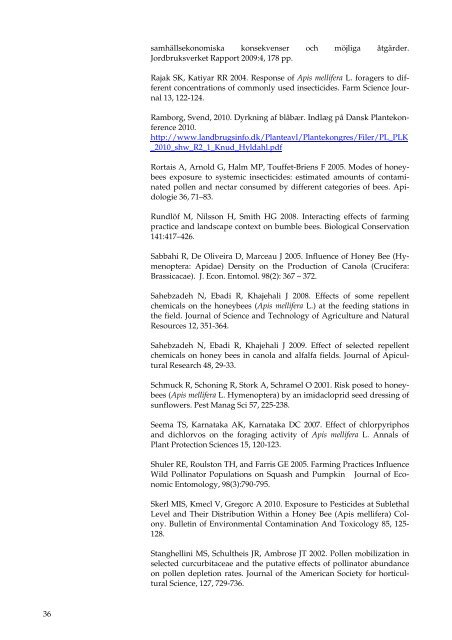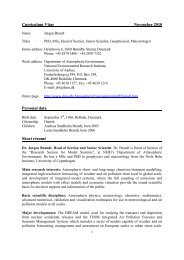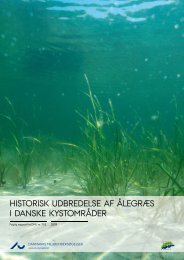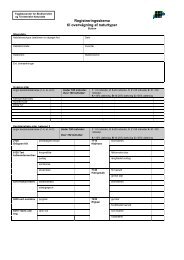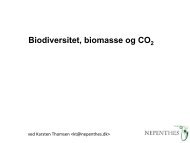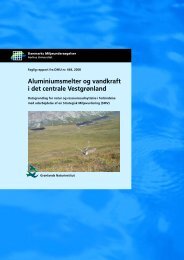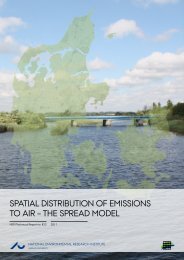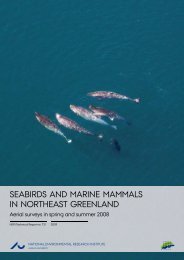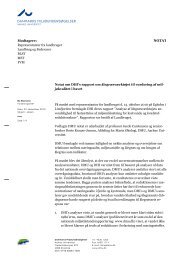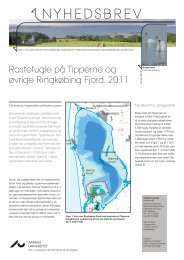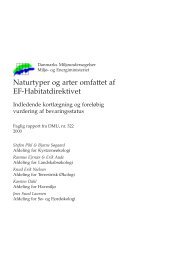Bestøvningsforhold og -behov i dyrkede afgrøder
Bestøvningsforhold og -behov i dyrkede afgrøder
Bestøvningsforhold og -behov i dyrkede afgrøder
You also want an ePaper? Increase the reach of your titles
YUMPU automatically turns print PDFs into web optimized ePapers that Google loves.
36<br />
samhällsekonomiska konsekvenser och möjliga åtgärder.<br />
Jordbruksverket Rapport 2009:4, 178 pp.<br />
Rajak SK, Katiyar RR 2004. Response of Apis mellifera L. foragers to different<br />
concentrations of commonly used insecticides. Farm Science Journal<br />
13, 122-124.<br />
Ramborg, Svend, 2010. Dyrkning af blåbær. Indlæg på Dansk Plantekonference<br />
2010.<br />
http://www.landbrugsinfo.dk/Planteavl/Plantekongres/Filer/PL_PLK<br />
_2010_shw_R2_1_Knud_Hyldahl.pdf<br />
Rortais A, Arnold G, Halm MP, Touffet-Briens F 2005. Modes of honeybees<br />
exposure to systemic insecticides: estimated amounts of contaminated<br />
pollen and nectar consumed by different categories of bees. Apidol<strong>og</strong>ie<br />
36, 71–83.<br />
Rundlöf M, Nilsson H, Smith HG 2008. Interacting effects of farming<br />
practice and landscape context on bumble bees. Biol<strong>og</strong>ical Conservation<br />
141:417–426.<br />
Sabbahi R, De Oliveira D, Marceau J 2005. Influence of Honey Bee (Hymenoptera:<br />
Apidae) Density on the Production of Canola (Crucifera:<br />
Brassicacae). J. Econ. Entomol. 98(2): 367 – 372.<br />
Sahebzadeh N, Ebadi R, Khajehali J 2008. Effects of some repellent<br />
chemicals on the honeybees (Apis mellifera L.) at the feeding stations in<br />
the field. Journal of Science and Technol<strong>og</strong>y of Agriculture and Natural<br />
Resources 12, 351-364.<br />
Sahebzadeh N, Ebadi R, Khajehali J 2009. Effect of selected repellent<br />
chemicals on honey bees in canola and alfalfa fields. Journal of Apicultural<br />
Research 48, 29-33.<br />
Schmuck R, Schoning R, Stork A, Schramel O 2001. Risk posed to honeybees<br />
(Apis mellifera L. Hymenoptera) by an imidacloprid seed dressing of<br />
sunflowers. Pest Manag Sci 57, 225-238.<br />
Seema TS, Karnataka AK, Karnataka DC 2007. Effect of chlorpyriphos<br />
and dichlorvos on the foraging activity of Apis mellifera L. Annals of<br />
Plant Protection Sciences 15, 120-123.<br />
Shuler RE, Roulston TH, and Farris GE 2005. Farming Practices Influence<br />
Wild Pollinator Populations on Squash and Pumpkin Journal of Economic<br />
Entomol<strong>og</strong>y, 98(3):790-795.<br />
Skerl MIS, Kmecl V, Gregorc A 2010. Exposure to Pesticides at Sublethal<br />
Level and Their Distribution Within a Honey Bee (Apis mellifera) Colony.<br />
Bulletin of Environmental Contamination And Toxicol<strong>og</strong>y 85, 125-<br />
128.<br />
Stanghellini MS, Schultheis JR, Ambrose JT 2002. Pollen mobilization in<br />
selected curcurbitaceae and the putative effects of pollinator abundance<br />
on pollen depletion rates. Journal of the American Society for horticultural<br />
Science, 127, 729-736.


